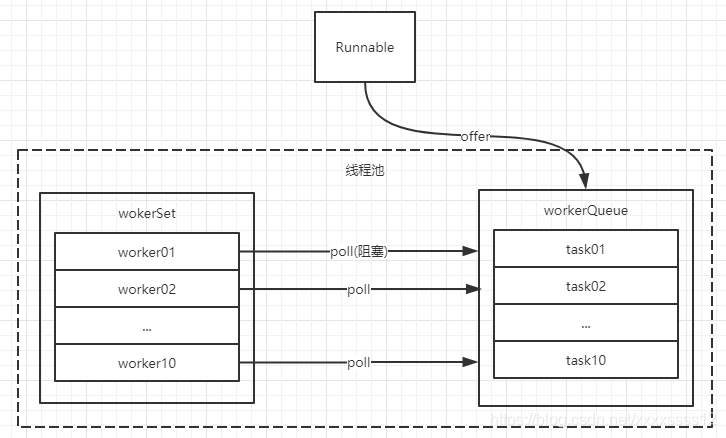
本文共 7992 字,大约阅读时间需要 26 分钟。
目录
参数解释
public ThreadPoolExecutor( int corePoolSize, int maximumPoolSize, long keepAliveTime, TimeUnit unit, BlockingQueueworkQueue, ThreadFactory threadFactory, RejectedExecutionHandler handler)
corePoolSize
核心线程数。在创建了线程池后,线程中没有任何线程,等到有任务到来时才创建线程去执行任务。默认情况下,在创建了线程池后,线程池中的线程数为0,当有任务来之后,就会创建一个线程去执行任务,当线程池中的线程数目达到corePoolSize后,就会把到达的任务放到缓存队列当中。
maximumPoolSize
最大线程数。表明线程中最多能够创建的线程数量。
keepAliveTime
空闲的线程保留的时间。
TimeUnit
空闲线程的保留时间单位。
BlockingQueue<Runnable>
阻塞队列,存储等待执行的任务。参数有ArrayBlockingQueue、LinkedBlockingQueue、SynchronousQueue可选。
ArrayBlockingQueue和PriorityBlockingQueue使用较少,一般使用LinkedBlockingQueue和Synchronous。线程池的排队策略与BlockingQueue有关。
- 普通的阻塞队列:如ArrayBlockingQueue,LinkedBlockingQueue,PriorityBlockingQueue等,只要队列的容量足够就能成功入队。
- 其他阻塞队列:就是SynchronousQueue,它的成功入队表示有线程同时在接收入队的数据,有线程能处理入队数据。这里留下后文解释,这个是解线程复用的关键。
ThreadFactory
线程工厂,用来创建线程
RejectedExecutionHandler
队列已满,而且任务量大于最大线程的异常处理策略。有以下取值
- ThreadPoolExecutor.AbortPolicy:丢弃任务并抛出RejectedExecutionException异常。
- ThreadPoolExecutor.DiscardPolicy:也是丢弃任务,但是不抛出异常。
- ThreadPoolExecutor.DiscardOldestPolicy:丢弃队列最前面的任务,然后重新尝试执行任务(重复此过程)
- ThreadPoolExecutor.CallerRunsPolicy:由调用线程处理该任务
线程池实现原理
1. 线程池状态
ThreadPoolExecutor中定义了一个volatile变量,另外定义了几个static final变量表示线程池的各个状态:
- volatile int runState;
- static final int RUNNING = 0;
- static final int SHUTDOWN = 1;
- static final int STOP = 2;
- static final int TERMINATED = 3;
runState表示当前线程池的状态,它是一个volatile变量用来保证线程之间的可见性;
对于四个状态解释如下:
- 当创建线程池后,初始时,线程池处于RUNNING状态;
- 如果调用了shutdown()方法,则线程池处于SHUTDOWN状态,此时线程池不能够接受新的任务,它会等待所有任务执行完毕;
- 如果调用了shutdownNow()方法,则线程池处于STOP状态,此时线程池不能接受新的任务,并且会去尝试终止正在执行的任务;
- 当线程池处于SHUTDOWN或STOP状态,并且所有工作线程已经销毁,任务缓存队列已经清空或执行结束后,线程池被设置为TERMINATED状态。
2. 任务的执行-execute方法
/** Proceed in 3 steps:** 1. If fewer than corePoolSize threads are running, try to* start a new thread with the given command as its first* task. The call to addWorker atomically checks runState and* workerCount, and so prevents false alarms that would add* threads when it shouldn't, by returning false.** 2. If a task can be successfully queued, then we still need* to double-check whether we should have added a thread* (because existing ones died since last checking) or that* the pool shut down since entry into this method. So we* recheck state and if necessary roll back the enqueuing if* stopped, or start a new thread if there are none.** 3. If we cannot queue task, then we try to add a new* thread. If it fails, we know we are shut down or saturated* and so reject the task.*//**谷歌翻译:执行一下3个步骤:1.如果正在运行线程数少于corePoolSize, 尝试使用传入Runnable作为其第一个任务启动新线程。 对addWorker的调用以原子方式检查runState和workerCount, 因此通过返回false来防止在不应该添加线程时发生的错误警报。 2.如果任务可以成功如队列,那么我们仍然需要 仔细检查是否应该添加一个线程(因为自上次检查后现有的线程已经死亡), 或者自从进入此方法后池关闭了。 所以我们重新检查状态,如果必要的话,如果没有,则回滚入队, 或者如果没有,则启动新的线程。 3.如果我们不能排队任务,那么我们尝试添加一个新线程。 如果失败,我们知道我们已关闭或饱和,因此拒绝该任务。*/public void execute(Runnable command) { if (command == null) throw new NullPointerException(); int c = ctl.get(); // 创建core核心线程-不涉及线程复用。 if (workerCountOf(c) < corePoolSize) { if (addWorker(command, true)) return; c = ctl.get(); } // 往队列里塞线程 if (isRunning(c) && workQueue.offer(command)) { int recheck = ctl.get(); if (! isRunning(recheck) && remove(command)) reject(command); else if (workerCountOf(recheck) == 0) addWorker(null, false); } else if (!addWorker(command, false)) reject(command);} 代码比较短,是addworker方法
private boolean addWorker(Runnable firstTask, boolean core) { retry: for (;;) { /* ctl是一个32位的线程池信息标识变量。 包含两个概念: workerCount:表明当前有效的线程数 runState:表明当前线程池的状态,是否处于 Running,Shutdown,Stop,Tidying,Terminate五种状态。 */ int c = ctl.get(); int rs = runStateOf(c); // Check if queue empty only if necessary. if (rs >= SHUTDOWN && ! (rs == SHUTDOWN && firstTask == null && ! workQueue.isEmpty())) return false; for (;;) { int wc = workerCountOf(c); if (wc >= CAPACITY || wc >= (core ? corePoolSize : maximumPoolSize)) return false; if (compareAndIncrementWorkerCount(c)) break retry; c = ctl.get(); // Re-read ctl if (runStateOf(c) != rs) continue retry; // else CAS failed due to workerCount change; retry inner loop } } boolean workerStarted = false; boolean workerAdded = false; Worker w = null; try { w = new Worker(firstTask); final Thread t = w.thread; if (t != null) { final ReentrantLock mainLock = this.mainLock; mainLock.lock(); try { // Recheck while holding lock. // Back out on ThreadFactory failure or if // shut down before lock acquired. int rs = runStateOf(ctl.get()); if (rs < SHUTDOWN || (rs == SHUTDOWN && firstTask == null)) { if (t.isAlive()) // precheck that t is startable throw new IllegalThreadStateException(); workers.add(w); int s = workers.size(); if (s > largestPoolSize) largestPoolSize = s; workerAdded = true; } } finally { mainLock.unlock(); } if (workerAdded) { t.start(); workerStarted = true; } } } finally { if (! workerStarted) addWorkerFailed(w); } return workerStarted;} 执行步骤:
1. 进入重试方法块(retry)
a.判断线程池是否已经shutdown,是则返回false
b.判断线程数是否大于了1<<29,是则返回false
c.判断线程数是否大于 corePoolSize or maximumPoolSize(根据core标志位区分),是则返回false
d.尝试增加workerCount,成功则跳出retry
e.重新获取runstatus,如果不为rs,则重新retry(a),否则重新尝试增加workerCount(b)
2. 新建worker对象,传入入参runnable
a.每个worker新建,都会创建一个线程
3.加锁
4.同步块执行:
a.判断状态是否为shutdown,如果是且worker对象线程存活,则抛出异常
b.往workers队列中添加worker
c.如果队列长度大于largestPoolSize,则更新largestPoolSize为队列长度值
d.启动worker中的线程:thread.start
5.小结
a.此时还没有结束。可以看到execute方法是新开线程的,怎么做到线程复用?
b.thread.start调用的是worker的run方法,run->runWorker方法是线程复用的关键
runWorker方法:
final void runWorker(Worker w) { Thread wt = Thread.currentThread(); Runnable task = w.firstTask; w.firstTask = null; w.unlock(); // allow interrupts boolean completedAbruptly = true; try { while (task != null || (task = getTask()) != null) { w.lock(); // If pool is stopping, ensure thread is interrupted; // if not, ensure thread is not interrupted. This // requires a recheck in second case to deal with // shutdownNow race while clearing interrupt if ((runStateAtLeast(ctl.get(), STOP) || (Thread.interrupted() && runStateAtLeast(ctl.get(), STOP))) && !wt.isInterrupted()) wt.interrupt(); try { beforeExecute(wt, task); Throwable thrown = null; try { task.run(); } catch (RuntimeException x) { thrown = x; throw x; } catch (Error x) { thrown = x; throw x; } catch (Throwable x) { thrown = x; throw new Error(x); } finally { afterExecute(task, thrown); } } finally { task = null; w.completedTasks++; w.unlock(); } } completedAbruptly = false; } finally { processWorkerExit(w, completedAbruptly); }} 步骤如下:
a.进入while(对于核心线程默认来说是死循环,当前正在运行的线程数超出核心线程,getTask会返回null)(参数allowCoreThreadTimeOut配置为true,核心线程getTask也会返回null。细节可以自己参阅)
b.获取worker中的firstTask
c.如果没有,则调用getTask方法(核心线程被blockingqueue阻塞)
d.获取到了task,调用其run方法。
e.销毁task。(task=null)
f.重新获取task(b)
3. 线程复用大致原理

Worker本身是一个runnable,他自身的执行逻辑是从workQueue中取runnable来执行其run方法。
转载地址:https://blog.csdn.net/xxxxssss12/article/details/93423065 如侵犯您的版权,请留言回复原文章的地址,我们会给您删除此文章,给您带来不便请您谅解!
发表评论
最新留言
关于作者
